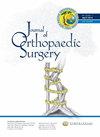胫骨远端斜截骨髓内钉固定减少软组织并发症的早期结果。
IF 1.6
4区 医学
Q3 ORTHOPEDICS
引用次数: 0
摘要
目的:在胫骨远端斜截骨术中,外固定架会增加钉位感染的风险,而钢板会导致伤口坏死,需要在软组织位置和长度之间做出妥协。我们首次报道髓内钉固定在这些截骨术中的早期结果,以避免软组织并发症。方法:纳入2017年至2021年间10例踝关节骨关节炎患者,分类为Takakura-Tanaka 3a至4期,未分类,经胫骨远端斜截骨治疗。从胫骨远端内侧到胫腓骨关节斜行截骨术。胫骨远端碎片在冠状面向远端旋转以复位。髓内钉固定用于稳定。由此产生的间隙用髂骨移植物填充。在手术前和最后随访时用日本足外科学会踝关节-后足量表和自我管理足部评估问卷对踝关节进行评估。进行放射学评估。结果:所有患者均在3个月内实现骨愈合。术后无创面坏死或矫正损失。日本社会量表得分由40.3±15.9分显著提高至87.5±12.6分(P < 0.01)。平均自我评估量表得分(疼痛和疼痛相关,身体功能和日常生活,社会功能,一般健康和幸福)显著改善。与鞋子相关的得分没有显著变化,但有所提高。术后无矫正损失,截骨部位平均增宽24.2 mm,开口角度22.6°。结论:我们的研究表明,在胫骨远端斜截骨术中,髓内钉固定截骨部位可以有效地防止软组织并发症,即使是在开口较大的截骨部位。本文章由计算机程序翻译,如有差异,请以英文原文为准。
Early results of intramedullary nail fixation in distal tibia oblique osteotomy for the reduction of soft tissue complications.
Purpose: During distal tibial oblique osteotomy, external fixators can increase pin site infection risk, whereas plates can cause wound necrosis, necessitating a compromise between soft-tissue position and length. We provide the first report of the early results of intramedullary nail fixation in these osteotomies for avoiding soft tissue complications. Methods: Ten ankles, classed as Takakura–Tanaka stages 3a to 4 and unclassified and treated via distal tibial oblique osteotomy for ankle osteoarthritis between 2017 and 2021, were included. Osteotomy was performed obliquely from the distal medial tibia to the tibiofibular joint. The distal tibial fragment was rotated distally in the coronal plane for realignment. An intramedullary nail fixation was applied for stabilization. The resulting gap was filled with iliac bone graft. Ankles were evaluated on the Japanese Society for Surgery of the Foot ankle–Hindfoot Scale and Self-Administered Foot Evaluation Questionnaire before surgery and at final follow-up. Radiographic assessments were performed. Results: Bone union was achieved within 3 months in all patients. There were no cases of wound necrosis or correction loss postsurgery. Japanese Society scale scores significantly improved from 40.3 ± 15.9 to 87.5 ± 12.6 (P < 0.01). Mean self-evaluation scale scores (pain and pain-related, physical functioning and daily living, social functioning, general health and well-being) improved significantly. shoe-related scores did not change significantly but improved. There was no correction loss after surgery, with an average widening of 24.2 mm and opening angle of 22.6° at the osteotomy site. Conclusion: Our study showed that intramedullary nail for fixation of the osteotomy site in distal tibial oblique osteotomy effectively prevents soft tissues complications even in osteotomy sites with large openings.
求助全文
通过发布文献求助,成功后即可免费获取论文全文。
去求助
来源期刊

Journal of Orthopaedic Surgery
ORTHOPEDICS-SURGERY
CiteScore
3.10
自引率
0.00%
发文量
91
审稿时长
13 weeks
期刊介绍:
Journal of Orthopaedic Surgery is an open access peer-reviewed journal publishing original reviews and research articles on all aspects of orthopaedic surgery. It is the official journal of the Asia Pacific Orthopaedic Association.
The journal welcomes and will publish materials of a diverse nature, from basic science research to clinical trials and surgical techniques. The journal encourages contributions from all parts of the world, but special emphasis is given to research of particular relevance to the Asia Pacific region.
 求助内容:
求助内容: 应助结果提醒方式:
应助结果提醒方式:


